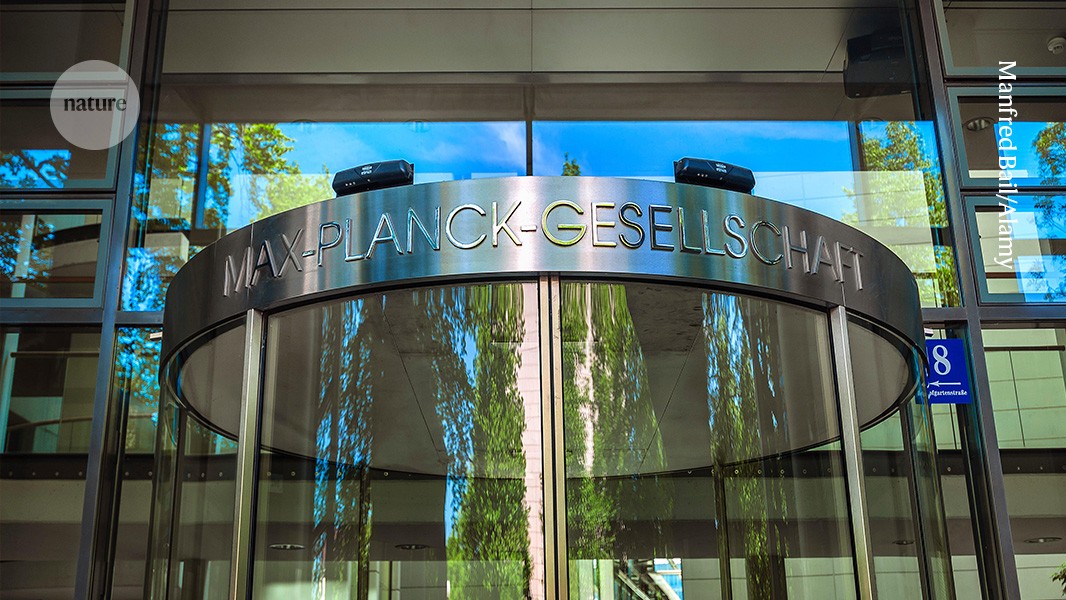
Postdocs at Germany’s Max Planck Society use survey data to lobby for improvements in working conditions.Credit: Manfred Bail/Alamy
Postdoctoral researchers conduct research, teach students and support the growing administrative burden in academia. However, because they are employed on short-term, temporary contracts, postdocs are forced to move on a semi-regular basis. Understanding their needs, wants and concerns is crucial to creating an academic landscape that works better for everyone.
To do that, we need high-quality data. But there were no robust data sets on the postdoc landscape in Germany, where we are based, because many institutions either do not survey their postdocs regularly or, if they do, seldom publish these data. To address this, researchers at the Max Planck Society (MPG) and the Leibniz Association set up the Max Planck PostdocNet and the Leibniz PostDoc Network, which we are part of, and started conducting regular surveys and publishing the findings1,2,3. The MPG’s first survey started in 2019; Leibniz’s biennial surveys began a year later. The latest survey reports are due out in the coming months.
Our past surveys show that postdocs are relatively happy with their advisers and institutes, but that many are nervous about future career unpredictability, and that this leads them to consider careers outside academia. Others want better career guidance. The surveys also showed that some groups struggle more with their mental health than others — particularly postdocs who are on a fellowship or stipend, and those with caring responsibilities for children and other family members.
Career resources for postdoctoral researchers
The surveys also revealed differences between the postdoc communities at two of Germany’s largest research organizations. From the responses, we now know, for example, that around 20% of Leibniz postdocs come from abroad, compared with 75% at MPG1,2. This knowledge will enable us to tailor future questions to our institutions and identify local problems. Both the MPG and Leibniz postdoc networks come together to learn from each other’s surveys and to determine what is specific to our own institutions and what problems persist throughout the German academic system.
Analysing the data from these surveys allows us to make recommendations to improve the working lives of postdocs at our respective institutions. These range from relatively minor changes to more significant departures from current working practices. These require often frank and difficult conversations with the leadership at our respective research organizations.
An example of this arose in 2020, when the MPG PostdocNet Survey investigated rumours that postdocs who had completed their PhDs in countries other than Germany had lower starting salaries than did colleagues who had completed their PhDs in the country. The survey results substantiated these rumours3. As a result, the MPG president established a task force, which has fixed many postdocs’ contracts. Subsequent surveys continue to monitor whether the task force’s regulations are being enforced fairly. Overall, it seems that they are.

Regina Becker is co-coordinator of the Leibniz PostDoc Network Survey group.Credit: LIfBi, Bamberg
In our view, any improvements to postdocs’ working lives benefit both the individuals concerned and academia as a whole. If you’re considering running a postdoc survey at your institution, here’s a checklist to get you started.
Who do you want to reach?
Reaching your target audience is not always easy. You must define what a postdoc is and then find a way to get the survey to them, for example, through e-mail lists. Do not underestimate the difficulty of this task. Neither Leibniz nor MPG had a freely available, centralized, comprehensive list of all postdocs, so be aware that you might have to track down postdoc colleagues or generate your own list — and then find creative ways to distribute and advertise the survey. Both networks used the institutes’ postdoc representatives to get a list of postdoc e-mails and then send around the survey links, while also advertising it on social media.
What do you want to know?
You might want to focus on specific aspects of postdoc life — such as pay or career development — to try to influence a change in policy. Alternatively, you might just want to carry out a general survey, looking at multiple aspects of postdoc life.
In either case, make sure you ask the questions necessary to reach your goal. Too many superfluous questions can be a headache both for respondents and for those analysing the data later on. Our early surveys had a broad scope to get an overview of demographics and postdocs’ general working situations, but, over time, the questions have tended to become more detailed. Because MPG has a large international population, the latest MPG PostdocNet Survey asked questions about immigration and academic mobility. The Leibniz PostDoc Network added questions about mental and physical health, and further explored postdocs’ working conditions.
Where can you get questions from?
This should be a top priority. Are you taking questions from other studies or designing your own? Check first if there are any existing, well-established questions in other surveys that serve your purposes. This saves time and enhances data quality. For example, in the latest MPG and Leibniz postdoc surveys, we implemented questions on mental health from previously published research4,5,6. It’s worth speaking to other survey teams to share ideas and best practices. If you would like to publish your findings, you must inform the participants on how you will use the data. It is necessary to include a data consent form, and you might also want to consider obtaining approval from your institution’s ethics committee, as the Leibniz PostDoc Network does.

Nicholas Russell is the Max Planck PostdocNet Survey’s working group leader.Credit: Britta Hoffmann
How many questions should you ask?
There is no one answer to this question. For the Leibniz PostDoc Survey, we asked around 100 questions — but filters meant not all participants were asked the full set. The last MPG PostdocNet Survey had around 120. Both surveys were quite large. Some would-be participants filled out part of the survey, but never finished it, and others did not start at all. In light of this, when a new question is proposed, we now drill down into what the question will tell us, why it is relevant (for instance, could the data be used to inform policy decisions?) and whether the postdoc survey is the right vehicle through which to ask it. The use of filters can also be beneficial — the Leibniz PostDoc Survey, for example, has a section aimed specifically at international postdocs. This can help to shorten surveys, but is not a cure-all. Try to make your survey as compact and concise as possible, this will help to boost your completed survey data. If it is not too time-consuming, participants will be more willing to take time out of their busy day to do the survey, and to recommend that others do the same.
How will you know that your survey is good?
We recommend pre-testing your survey with a select group of people. They will help you to determine whether your questions are clearly worded and to identify any errors. Ours are tested on 10–20 postdocs, usually members of our respective steering committees. We also recommend involving a survey expert, either in your survey group or to act as a critical friend. At MPG, we discuss our questions with staff at MPG headquarters who have experience of running surveys, and at least one member of the Leibniz survey group is a survey expert.
How will you communicate the findings?
Give early consideration to how you will use the survey findings. For example, both of ours are publicly available as reports. These take a long time to write, edit and publish. If you are naming an institute, network or organization, you will need to give them ample opportunity to comment on the findings of the report, and you might also want to include their responses. This, along with the whole survey process, could take longer than you might think, depending on the survey’s size and scope.
Should you make the data publicly available?
One advantage of making the data set publicly available is to help ensure continuity. If, for example, one or more of the survey team moves on, their successors can easily see what questions were asked in previous surveys, and repeat or modify these accordingly. For the Leibniz PostDoc Survey, we publish an anonymized data set after the release of the survey report. The MPG PostdocNet does not publish its data set. Either option is fine, but you must ensure that any published data set does not risk identifying participants.
What impact could your survey have?
Both networks set up meetings far in advance with various administrative departments to discuss the findings that are most important to us.

Harry Williams is co-coordinator of the Leibniz PostDoc Network Survey group.Credit: Harry Michael Williams
At Leibniz, we present the results at one of the quarterly meetings of the Leibniz Association Präsidium (the executive board), which includes the overarching Leibniz Association president, the vice-presidents and a selection of other senior representatives. This body oversees the development of the Leibniz Association’s 96 individual research institutes and 8 research museums, which are thematically organized into 5 Leibniz sections. These Leibniz sections also meet on a regular basis and, following completion of our report, we present our findings to each section, typically in the autumn. This takes up quite a bit of time, so we tend to split the meetings between us. On the whole, these meetings are positive and the feedback we get from senior leadership is mainly gratitude, for highlighting areas in which institutes can improve.
Similarly, at the MPG, several departments have been grateful for our findings, because they can use our work to advocate for change. As an example, our work aided the Planck Academy, a career-development programme at MPG, to construct seminars and courses more relevant to postdocs, and also helped the academy better advertise its own services, so that postdocs know about the various career-development opportunities at their disposal.
It’s important to remember the impact your findings can have when they are made public. The 2022 MPG PostdocNet Survey was publicized quite heavily after an article in Der Spiegel quoted our mental-health statisticsan article in Der Spiegel quoted our mental-health statistics. This had both positive and negative effects, and resulted in some tense conversations with MPG’s leadership. Our goals are never malicious, but surveys — particularly public ones — can have unintended consequences, especially if you do not have an effective media strategy.
It is also important to put your results into context when you write your report. We published a page of frequently asked questions (FAQs) with the report, explaining our key findings and putting them into context, both in academia and in society as a whole, and these FAQs were used in some media reports. If it is available to you, the communications department at your society or institute might be able to assist you should there be more media coverage than anticipated, either positive or negative. Lastly, it might benefit you to offer a public presentation of your data online and record any presentations, so that your work is put into context through a different medium.



